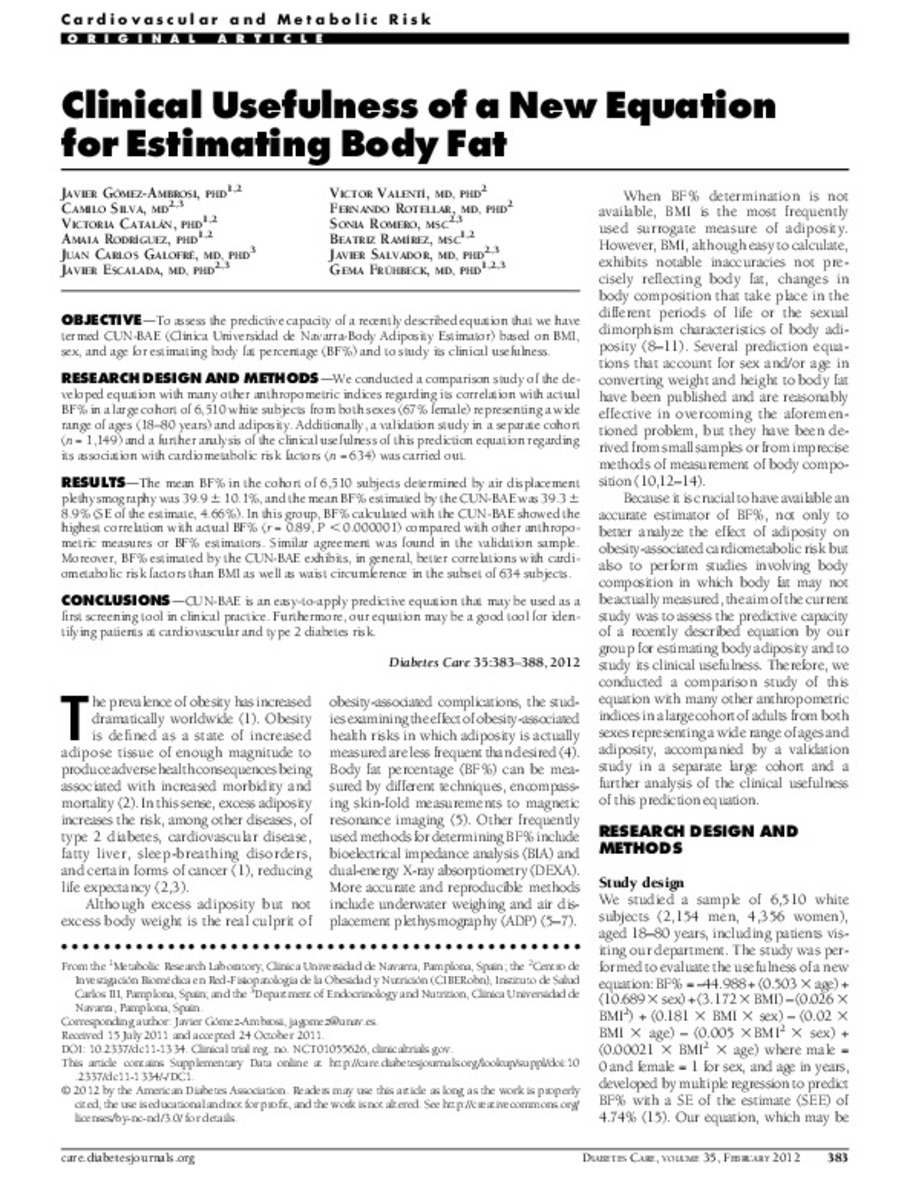Registro completo de metadatos
| Campo DC | Valor | Lengua/Idioma |
|---|---|---|
| dc.creator | Gomez-Ambrosi, J. (Javier) | - |
| dc.creator | Silva, C. (Camilo) | - |
| dc.creator | Catalan, V. (Victoria) | - |
| dc.creator | Rodriguez, A. (Amaia) | - |
| dc.creator | Galofre, J.C. (Juan Carlos) | - |
| dc.creator | Escalada, J. (Javier) | - |
| dc.creator | Valenti, V. (Víctor) | - |
| dc.creator | Rotellar, F. (Fernando) | - |
| dc.creator | Romero, S. (Sonia) | - |
| dc.creator | Ramirez, B. (Beatriz) | - |
| dc.creator | Salvador, J. (Javier) | - |
| dc.creator | Frühbeck, G. (Gema) | - |
| dc.date.accessioned | 2014-08-14T08:14:15Z | - |
| dc.date.available | 2014-08-14T08:14:15Z | - |
| dc.date.issued | 2012-02 | - |
| dc.identifier.citation | Gómez-Ambrosi J, Silva C, Catalán V, Rodríguez A, Galofré JC, Escalada J, et al. Clinical usefulness of a new equation for estimating body fat. Diabetes Care. 2012 Feb;35(2):383-388 | es_ES |
| dc.identifier.issn | 0149-5992 | - |
| dc.identifier.uri | https://hdl.handle.net/10171/36325 | - |
| dc.description.abstract | OBJECTIVE: To assess the predictive capacity of a recently described equation that we have termed CUN-BAE (Clínica Universidad de Navarra-Body Adiposity Estimator) based on BMI, sex, and age for estimating body fat percentage (BF%) and to study its clinical usefulness. RESEARCH DESIGN AND METHODS: We conducted a comparison study of the developed equation with many other anthropometric indices regarding its correlation with actual BF% in a large cohort of 6,510 white subjects from both sexes (67% female) representing a wide range of ages (18-80 years) and adiposity. Additionally, a validation study in a separate cohort (n = 1,149) and a further analysis of the clinical usefulness of this prediction equation regarding its association with cardiometabolic risk factors (n = 634) was carried out. RESULTS: The mean BF% in the cohort of 6,510 subjects determined by air displacement plethysmography was 39.9 ± 10.1%, and the mean BF% estimated by the CUN-BAE was 39.3 ± 8.9% (SE of the estimate, 4.66%). In this group, BF% calculated with the CUN-BAE showed the highest correlation with actual BF% (r = 0.89, P < 0.000001) compared with other anthropometric measures or BF% estimators. Similar agreement was found in the validation sample. Moreover, BF% estimated by the CUN-BAE exhibits, in general, better correlations with cardiometabolic risk factors than BMI as well as waist circumference in the subset of 634 subjects. CONCLUSIONS: CUN-BAE is an easy-to-apply predictive equation that may be used as a first screening tool in clinical practice. Furthermore, our equation may be a good tool for identifying patients at cardiovascular and type 2 diabetes risk. | es_ES |
| dc.language.iso | eng | es_ES |
| dc.publisher | American Diabetes Association | es_ES |
| dc.rights | info:eu-repo/semantics/openAccess | es_ES |
| dc.subject | Humans | es_ES |
| dc.subject | Body fat | es_ES |
| dc.subject | Adipose Tissue | es_ES |
| dc.title | Clinical usefulness of a new equation for estimating body fat | es_ES |
| dc.type | info:eu-repo/semantics/article | es_ES |
| dc.identifier.doi | http://dx.doi.org/10.2337/dc11-1334 | es_ES |
Ficheros en este ítem:
Estadísticas e impacto
Los ítems de Dadun están protegidos por copyright, con todos los derechos reservados, a menos que se indique lo contrario.






